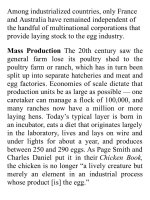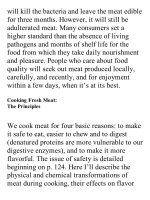On food and cooking the science and lore of the kitchen ( PDFDrive ) 115
Bạn đang xem bản rút gọn của tài liệu. Xem và tải ngay bản đầy đủ của tài liệu tại đây (112.02 KB, 2 trang )
cheese. Thanks to newly sensitive analytical
instruments, dairy chemists have recently
verified what connoisseurs have known for
centuries:ananimal’sdietinfluencesitsmilk
andthecheesemadefromit.Frenchstudiesof
alpine Gruyère found a larger number of
flavor compounds in cheeses made during
summer pasturage compared to winter stable
feeding, and more herbaceous and floral
terpenes and other aromatics (p. 273) in
mountain cheeses than cheeses from the high
plateaus, which in turn have more than
cheesesfromtheplains(alpinemeadowshave
more diverse vegetation than the grassy
lowlands).
Likefruits,cheesesmadefrompasturefed
animalsareseasonal.Theseasondependson
thelocalclimate—thesummerisgreenin
theAlps,thewinterinCalifornia—andhow
longittakesaparticularcheesetomature.
Cheesesmadefrompasturagearegenerally
recognizablebytheirdeeperyellowcolor,due
tothegreatercontentofcarotenoidpigments
infreshvegetation(p.267).(Brightorange
cheeseshavebeendyed.)
PasteurizedandRawMilksInmoderncheese
production, the milk is almost always
pasteurized to eliminate disease and spoilage
bacteria.Thisisreallyapracticalnecessityin
industrial cheesemaking, which requires that
milk be pooled and stored from many farms
and thousands of animals. The risk of
contamination — which only takes one
diseased cow or dirty udder — is too great.
Sincethelate1940s,theU.S.FoodandDrug
Administration has required that any cheese
madefromunpasteurized,“raw”milkmustbe
aged a minimum of 60 days at a temperature
above35ºF/2ºC,conditionsthatarethoughtto
eliminate whatever pathogens might have
beeninthemilk;andsincetheearly1950sit
has also banned the import of raw-milk
cheeses aged less than 60 days. This means









